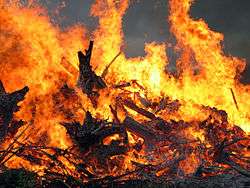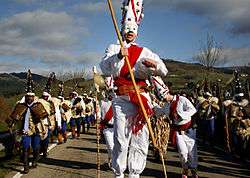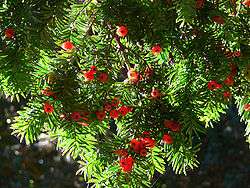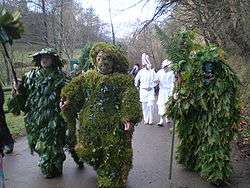Cantabrian mythology
It seems that the native mythology of Cantabria connected, from the beginning and with the passing of the years, with Celtic and Roman mythology becoming partly related with legends and traditions from the rest of the Cantabrian Mountains. In most cases its deeper meaning, passed from parents to children through oral tradition, has been diluted, either because this meaning has been lost or because the classic writers didn't gather all the popular wealth and mentality of the time, paying attention only to cults and divinities that were similar to theirs. On the other hand, the Romanization and later ascendancy of Christendom transformed the sense and representation of these pagan rites, reaching in many cases religious syncretism.



Even so, Cantabrian people still conserve more apologues and legends with a great ritual or behavioral component than significant tales.
Divinities
Among the remains of myths that still persist as substrate in the Cantabrian tradition is the cult to great protective divinities, like the adoration to the Sun, as is evident in Cantabrian Steles, and in relation to the cult of the fire.[1] Also, the Cantabrians worshiped a supreme divinity-father which in Roman time was associated with Jupiter and the cult to the Sun, and later with the Christian God.[2]
Combined with the marked warlike disposition of the Cantabrians, appears a god of war, subsequently identified as the Roman Mars, to whom they offered sacrifices of male goats, horses, or large numbers of prisoners, as Strabo, Horace and Silius Italicus point out.[3][4][5] These hecatombs were accompanied by the drinking of the still warm blood of the horses,[6] as Horace mentions in regard to the concanos, and it will be, then, a true communion.
et laetum equino sanguine Concanum— Horace. Carm. III 4. v29-36
For the ancient Cantabrians these practices had a mystic origin thanks to the belief that these animals were sacred.[7] Some link this ritual very closely with the variant of the Celtic solar god Mars and that these animals they represented his reincarnation.[8][9]
The Human sacrifices among the northern peoples are also mentioned by Saint Martin of Braga[10] and they will have the same value of redemption and prediction that for the rest of the Celts of Gaul, where they were very frequent. Then Strabo will tell that those who examined the prisoners' viscus, covering them with thin tunics, cut the right hand and consecrated it to the gods. The way to predict the future depended on the fall of the victim.[11]
Together with this war deity, appear the germinator mother-goddesses related to the Moon, remaining almost until the present time, when they have a clear influence in rural environments, evident in the phases of sowing and gathering of the crops.
In the same way, the cult to a god of the sea was assimilated in Roman times through Neptune (a statuette of this deity, but with features of the original Cantabrian divinity, was found in Castro Urdiales).
The ancient Cantabrians believed in the immortality of the spirit. Thus they demonstrated in their funeral rites where cremation predominated, with the exception of those who died in combat, who had to rest in the battlefield until vultures opened their entrails to take their soul to Heaven and reunite in glory with their ancestors. This practice is testified in the engravings of the Cantabrian stele of Zurita.
Sacrifice played a major role in the complex Cantabrian society in both its aspects: as a means to fulfill the divine will as well as the prevalence of abnegation to collectivity against the individual. Then, in a warring society, as the Cantabrian, immolation was not considered as primitive or barbarian but the strong determination required from the person to commit sacrifice gave it a great importance. That was the case of the devotio, a singular and extreme sacrifice practices by the Cantabrians in which the warring communities joined their destiny to that of their leader.[12]
Telluric and arboreal mythology




At the same time, a terrenal mythology of adoration to Gaia, the Mother Earth, exists through the divinization of animals, trees, mountains and waters like elementary spirits. Beliefs, on the other hand, common to all the people who received Celtic influences.
Places like Pico Dobra, in the valley of Besaya, have given evidence of their sacred condition since pre-Roman times through the altar dedicated to the Cantabrian God Erudinus, dated on the year 399, which demonstrates that these rites extended beyond the instauration of Christianity in the Roman Empire as official religion. In the same way toponyms like Peña Sagra ("Sacred Mount"), Peña Santa ("Saint Mount"), Mozagro (Montem sacrum = Sacred Mount) or Montehano (montem fanum = Mount of the Sanctuary)[13] indicate that they have been considered sacred places from the most remote antiquity.
Also divinized were the rivers and water bodies. At the Mount Cildá appeared an area dedicated to the mother goddess Mater Deva, known though the Celtic world and personified in the Deva river. At Otañes it was found a patera dedicated to the nymph of a fountain with medicinal properties. Pliny the Elder[14] mentions the existence in Cantabria of one of the intermittent fountains -the Fuentes Tamáricas- adored by the Cantabrians and that had a prophetic value and that corresponded to the current Velilla del Río Carrión.[15] Suetonius, in a story about the life of Galba, points out as a symbol of good divination having found, during his stay at Cantabria, 12 axes in a lake.[16] There were, without any doubt ex-votos left there following their tradition (which is also found in other European peoples), which suggests a cult to the lakes.[17] The offerings to the waters of stips, or bronze coins of low value, as well as other pieces of higher value, as denari, aurei and solidi, its manifested in the presence of some of those pieces at La Hermida, Peña Cutral, Alceda and at the Híjar river.
At the same time, the forest were also divinized, a cult with clear Celtic influences through an arboreal mythology. Some species of trees were specially respected; the yew and the oak. The former is the most emblematic and symbolic species of Cantabria and it was venerated by Cantabrians in antiquity, being part of some of their rituals. We know by the accounts of Silius, Florus, Pliny and Isidore of Seville, that Cantabrians committed suicide with poison they got from the leaves of this tree,[18] but they preferred death rather than slavery.[19][20][21][22] It is usual to find them at the town squares, at cemeteries, churches, chapels, palaces and big houses because of being considered a witness tree, which has allowed them to perpetuate that halo of mystery and sanctity that surrounds everything related with this species.[23]
The oak is the Celtic tree by excellence maybe because it is the most sacred species for the druids, from which they recollected the muérdago. It is a species that carries lots of folkloristic, symbolic and magic meanings in Cantabria, it was frequent to use it as "Maypole", the pole that presides the festivities in some towns, around which the people dance to celebrate the rebirth of the vegetal life. The Oak symbolized the union between the sky and the earth, image that gave them the position as axis of the world. They tend to attract lightnings, so it played a preponderant role in the ceremonies to attract the rain and the fire in all Europe.
Oaks, beeches, holly oaks and yews were used as a place of tribal meetings for many generations where religious and secular laws were taught. Until recent times it was usual to celebrate open meetings under centennial trees (the meetings of Trasmiera got together at Hoz de Anero, Ribamontán al Monte, under a great holly oak that still stands).
Significative dates
As in other peoples, in Cantabria there were dates that have been appropriated since antiquity for rituals and legends, days that are charged with dark or ancient meanings. For this reason during the summer solstice, the "night is magic". Tradition says, in all different variants, that the Caballucos del Diablu (Damselflies, literally "Devil's little horses") and the witches lose their powers after dusk and the curanderos gain control over them; plants as the four-leaf clover, the fruit of the elder berry, the leaves of the willow, the common juniper or the tree heath among others cure and bring happiness if they are collected at dawn. Around Christmas (winter solstice) there were ritual ceremonies, remains of ancient cults to the tree, the fire and the water. Around those dates the sources of the rivers and the balconies were dressed with flowers and people danced and jumped over the fire.
Also important were specific moments of the day, mostly the twilight. Ancient Cantabrians talked about "The Sun of the Dead", referring to the last part of the day when the Sun was still visible and that they believed was sent by the dead. They believed that it marqued the moment in which the dead came back to life and several author have related it with the solar cult.[24]
Mythological creatures
Cantabrian people have not only telluric and natural divinities, but also fabulous beings with different aspects that people feared or adored and have legends and histories on their own. There are many of them in Cantabrian mythology, yet the most important are:
- The Ojáncanu. The sorrow of Cantabria, this creature embodies the evil among the Cantabrians and represents the cruelty and the brutality. This giant cyclops is the Cantabrian version of the Greek Polyphemus that appears in other Indoeuropean mythologies.[25]
- The Ojáncana or Juáncana. Wife of the former, is even more ruthless as children are counted among her victims.
- The Anjana. Is the antithesis of the Ojáncanu and the Ojáncana. Good and generous fairy, she protects honest people, the lovers and those who get lost in the woods or roads.
- The goblins. This is a large group of little mythological creatures, most of them mischievous. There are two groups among them, the domestic goblins, those who live in or around houses as Trasgu and Trastolillu; and the forest goblins, as Trenti and Tentiruju.
There are other fabulous beings that populate the mythological pantheon of Cantabria, as the Ventolín, the Caballucos del Diablu, the Nuberu, the Musgosu, the Culebre, the Ramidreju, etc. Or beautiful legends such as the Sirenuca ("Little Mermaid"), a beautiful but disobedient and spoiled young lady whose vice was climbing the most dangerous cliffs of Castro Urdiales to sing with the waves and was transformed into an ephydriad due to this behavior. Another popular legend is the Fish-man, the story of a man from Liérganes who loved to swim and that got lost in the Miera river and was eventually found at the Bay of Cádiz, transformed into a strange aquatic being.
Interpretations of Cantabrian Mythology
Consideration of the mythical beings and legends within Cantabrian culture suggests a societal desire for the expression of fear and for the quality of courage to endure the hostile and dangerous environment in which these people came to prominence.
Even today some Cantabrians worship the Anjanas, not being converted to Christianity or other modern religions. These people follow their ancestral beliefs that some gifts are granted by these good fairies of the mountains, and even today the Ojáncanu is used to scare the children when they are mischievous. But this world of meanings and values has become diluted little by little with the advance of the modernity and time, giving place to new urban legends and forgetting the old deities.
It is until now that Cantabrian mythology has attracted the interest of scholars, specially after the publishing of the recompilation made by the writer Manuel Llano Merino (1898–1938) throughout his work, enriched with oral tradition, and several other writers like Adriano García-Lomas.
References
- ↑ bonfires of Saint John, coincident with solstice of summer, could be a reminiscence
- ↑ a beautiful bronze sculpture was discovered at Herrera de Camargo
- ↑ Estr. III,3,7
- ↑ Carm. III,4,34
- ↑ Silius III, 361
- ↑ Tacitus considers them by the Germans as ministers of the gods:
se (sacerdotes) enim ministros deorum, illos (equos) coscious putant
— Germ. X - ↑ Julio Caro Baroja suggests the possibility of the existence of an equestrian deity among Hispanian Celts similar to that of the other European Celts.
- ↑ E. Thevenot. Sur les traces des Mars Celtiques, Bruges, 1995.
- ↑ At Numantia, these representations of the horse-god are decorated with solar signs.
- ↑ De correctione rusticorum VIII
- ↑ José María Blázquez Martínez (1977). "La religiosidad de los pueblos hispanos vista por los autores griegos y latinos" (in Spanish). Retrieved 2007-09-08.
- ↑ Juan Carlos Cabria. "Mitos y leyendas de Cantabria. El sacrificio, vía de unión con la divinidad" (in Spanish). Otra Realidad. Retrieved 2007-07-12.
- ↑ Actually there is an old monastery whose origins date back to the 14th century and where there already was a small chapel-
- ↑ Plin.,NH XXXI 23-24
- ↑ According to Pliny there would be three close fountains whose waters got together in one pond and stop circulating from 12 to 20 days, interpreting these discontinuity of the flow as a negative sign.
- ↑ Suet., Galba, VIII 13
- ↑ A. Schulten. Los cántabros y astures y su guerra con Roma. Madrid. 1943
- ↑ The leaves of the yews and its seed, present in its red berries, contain a very toxic alkaloid, the taxine, that provokes hypotension and cardiac arrests if consumed.
- ↑ Silius III, 328
- ↑ Florus II, 33, 50
- ↑ Pliny XVI, 50
- ↑ Isidore Book XVII, 9, 25
- ↑ It is worth mentioning the presence of millenary yews as the one that exists next to the pre-Roman church of Saint Mary of Lebeña and under which the town councils took place. This tree, present in the Inventory of Singular Trees of Cantabria Archived May 12, 2008, at the Wayback Machine., has been severwly damaged by a recent gale.
- ↑ Juan Carlos Cabria. "El culto solar II" (in Spanish). Retrieved 2008-06-20.
- ↑ Beings similar to the Ojáncanu or the Ojáncana are found in other pantheons such as the Extremenian mithology (the Jáncanu or Pelujáncanu and the Jáncanas, where is also evident the similar denominations , "Archived copy" (PDF). Archived from the original (PDF) on 2007-02-03. Retrieved 2008-06-20., ,) or the Basque mithology (Tartalo or Torto, among others.)
Bibliography
- Mitos y Leyendas de Cantabria. Santander 2001. Llano Merino, M.. Ed. Librería Estvdio. ISBN 84-95742-01-2
- Los Cántabros. Santander 1983. González Echegaray, J.. Ed. Librería Estvdio. ISBN 84-87934-23-4
- Gran Enciclopedia de Cantabria. Santander 1985 (8 tomos) y 2002 (tomos IX, X y XI). Various. Editorial Cantabria S.A. ISBN 84-86420-00-8
- Mitología y Supersticiones de Cantabria. Santander 1993. Adriano García-Lomas. Ed. Librería Estvdio. ISBN 84-87934-87-0
External links
- Cantabrian Mythology (Spanish)
- Cantabria joven. Mythology and Legends (Spanish)